By Leen Randell
Updated: Jul 04, 2024
10 Best Herbal Decoctions For Gum Pain

Herbal decoctions for gum pain are a natural remedy made by steeping herbs in hot water to create a soothing liquid that helps alleviate discomfort caused by gum inflammation, sensitivity, and recession.
These decoctions help reduce swelling, kill bacteria, and promote healing by leveraging the medicinal properties of specific herbs. For example, ginger and peppermint decoctions have anti-inflammatory properties, while sage and chamomile decoctions possess antimicrobial properties.
By using these decoctions as a mouthwash or gargle, individuals can enjoy relief from gum pain, improving their overall oral health and quality of life.
The following article describes in detail the most important decoctions for gum pain, including medicinal properties, parts of herbs to use, and recipes for preparations.
- 1. Salvia officinalis
- 2. Teucrium polium
- 3. Centaurea cyanus
- 4. Calendula officinalis
- 5. Glycyrrhiza glabra
- 6. Cinnamomum verum
- 7. Echinacea angustifolia
- 8. Hypericum perforatum
- 9. Viburnum opulus
- 10. Artemisia absinthium
- What is the best combination of herbal decoctions to use for gum pain?
- What ailments similar to gum pain are treated with herbal decoctions?
1. Salvia officinalis
Sage decoctions helps with gum pain because of its natural anti-inflammatory properties, which reduce swelling and ease discomfort in the gums.
The antioxidants present in sage also help to combat free radicals that can exacerbate gum inflammation. Additionally, sage's antimicrobial properties prevent the growth of bacteria that can cause gum disease, further contributing to relief from gum pain.
By consuming sage decoctions, individuals may experience a reduction in gum pain and inflammation, promoting overall oral health and well-being.
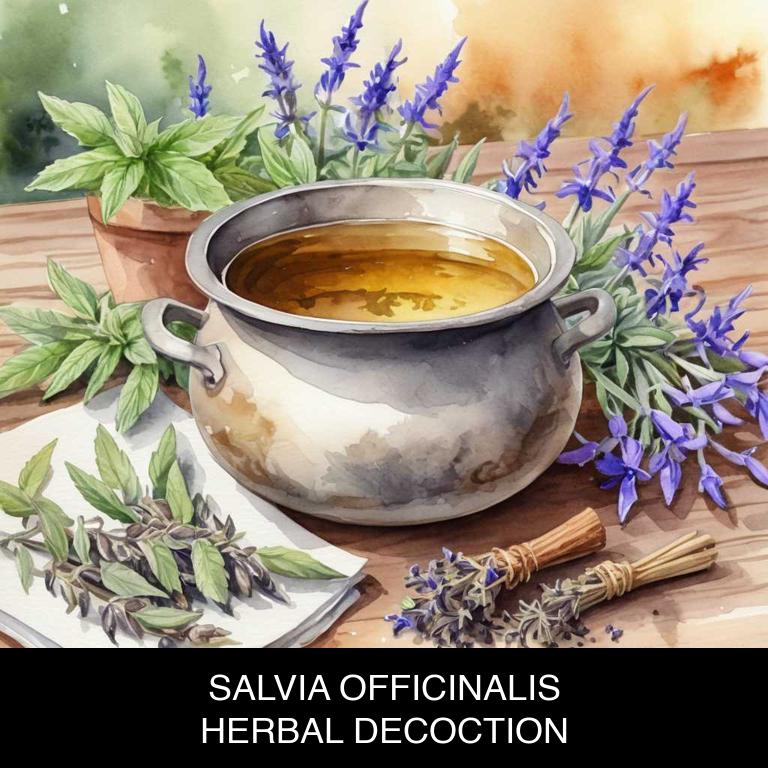
Medicinal Constituents
The list below shows the primary medicinal constituents in Salvia officinalis decoctions that help with gum pain.
- Rosmarinic acid: A phenolic compound found in Salvia officinalis decoctions that helps alleviate gum pain by reducing inflammation and acting as an antioxidant to protect gum tissues.
- Ursolic acid: A terpene with anti-inflammatory properties that helps in reducing gum pain by inhibiting the production of pro-inflammatory enzymes and chemicals.
- Salvianolic acid: A phenolic compound with antioxidant and anti-inflammatory properties that helps in soothing gum pain by protecting gum tissues from oxidative damage and reducing inflammation.
Parts Used
The list below shows the primary parts of sage used to make decoctions for gum pain.
- Leaves: They are used for their anti-inflammatory and antibacterial properties to help soothe and heal gum pain.
- Roots: They are used for their analgesic and anti-inflammatory properties to reduce pain and inflammation in the gums.
- Stems: They are used for their antibacterial properties to prevent infections and promote healing in the gums.
Quick Recipe
The following recipe gives a procedure to make a basic sage for gum pain.
- Harvest 20-30 grams of salvia officinalis leaves and flowers from a clean and well-maintained herb garden.
- Dry the harvested plant material in a warm and well-ventilated area for 1 to 2 weeks.
- Grind the dried plant material into a fine powder using a mortar and pestle or a coffee grinder.
- Combine 1-2 teaspoons of the powdered plant material with 250ml of boiling water in a saucepan.
- Steep the mixture for 5-10 minutes then strain and discard the solids to make the decoction.
2. Teucrium polium
Wood sage decoctions helps with gum pain because it contains anti-inflammatory properties that reduce swelling and ease discomfort.
The antibacterial compounds in wood sage also combat the bacteria that cause gum disease, promoting a healthy gum environment.
Additionally, its soothing and calming effects help to alleviate inflammation and pain, making it an effective natural remedy for alleviating gum pain associated with conditions such as gingivitis and periodontitis.
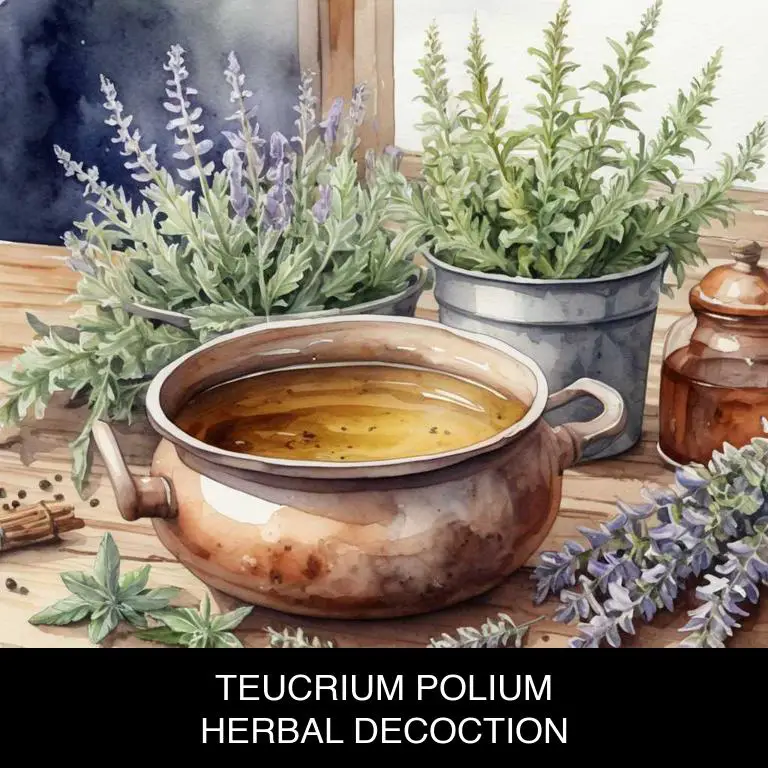
Medicinal Constituents
The list below shows the primary medicinal constituents in Teucrium polium decoctions that help with gum pain.
- Flavonoids: These plant compounds may help alleviate gum pain by reducing inflammation and oxidative stress in the gum tissues, thus promoting healing and comfort.
- Phenolic acids: As potent antioxidants, phenolic acids in Teucrium polium decoctions may help mitigate inflammation and prevent tissue damage, thereby reducing gum pain and discomfort.
- Diterpenes: Some studies suggest that diterpenes present in Teucrium polium may exhibit anti-inflammatory and analgesic properties, potentially providing relief from gum pain and promoting overall oral health.
Parts Used
The list below shows the primary parts of wood sage used to make decoctions for gum pain.
- Leaves: Rich in essential oils and flavonoids, which help to reduce inflammation and alleviate gum pain.
- Roots: Contain compounds with anti-inflammatory and antiseptic properties, which aid in soothing gum pain and reducing infection.
- Stems: Have been traditionally used to make decoctions for oral health, possibly due to their anti-inflammatory and antimicrobial properties.
Quick Recipe
The following recipe gives a procedure to make a basic wood sage for gum pain.
- Gather 10-20 grams of dried teucrium polium roots and leaves, and store them in an airtight container.
- Measure 250 milliliters of water in a saucepan and bring it to a boil over high heat.
- Add the dried teucrium polium to the boiling water, then reduce heat to a simmer.
- Steep the mixture for 10-15 minutes, then strain it through a cheesecloth or a fine-mesh sieve.
- Discard the solids and store the cooled decoction in a glass bottle in the refrigerator for up to 3 days.
3. Centaurea cyanus
Cornflower decoctions helps with gum pain because it contains potent anti-inflammatory properties that soothe and calm the gums.
The decoction's flavonoids, such as apigenin and luteolin, have been shown to reduce inflammation and alleviate discomfort.
Additionally, cornflower's antioxidants help protect the gums from further damage caused by bacteria and toxins, promoting healthy gum tissue and reducing the risk of infection.
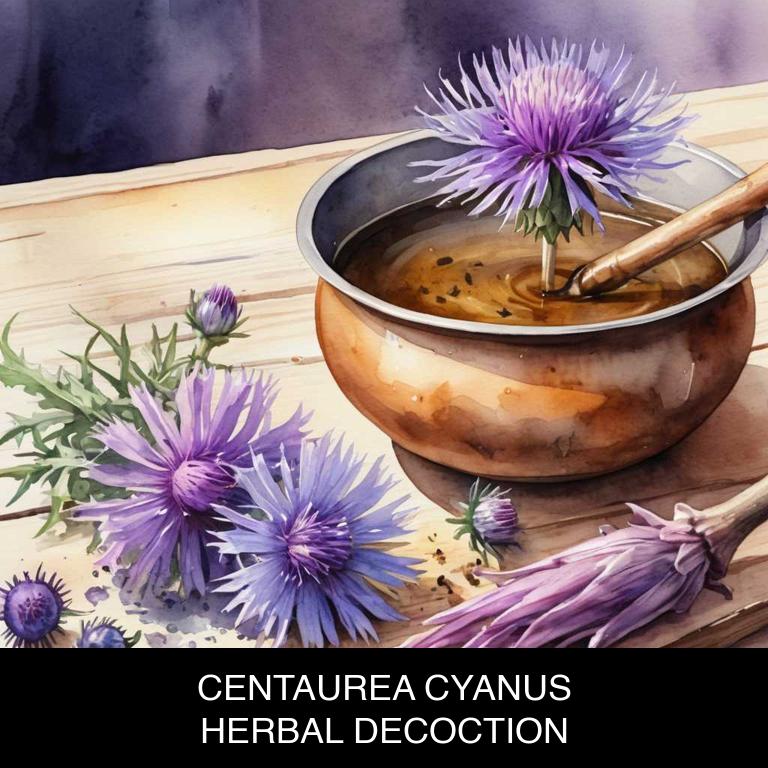
Medicinal Constituents
The list below shows the primary medicinal constituents in Centaurea cyanus decoctions that help with gum pain.
- Chrysin: Chrysin, a flavonoid, has anti-inflammatory properties, which help reduce inflammation and alleviate pain associated with gum pain.
- Cynarin: Cynarin, a sesquiterpene lactone, possesses anti-inflammatory and analgesic properties, which help soothe and calm gum pain by reducing inflammation and providing pain relief.
- Apigenin: Apigenin, a flavonoid, exhibits anti-inflammatory and antioxidant activities, which help mitigate gum pain by reducing inflammation, promoting tissue repair, and preventing oxidative damage.
Parts Used
The list below shows the primary parts of cornflower used to make decoctions for gum pain.
- Seeds: Used for their anti-inflammatory and antimicrobial properties, which help to reduce gum inflammation and prevent infection.
- Roots: Used for their ability to reduce gum inflammation and fight off infections due to their bioactive compounds.
- Leaves: Used for their astringent and anti-inflammatory properties, which help to soothe and calm gum pain and inflammation.
Quick Recipe
The following recipe gives a procedure to make a basic cornflower for gum pain.
- Gather 30 grams of dried centaurea cyanus flowers and clean them thoroughly with a fine-mesh sieve.
- Combine the cleaned flowers with 1 liter of cold water in a saucepan and bring to a boil.
- Reduce the heat to a simmer and allow the mixture to steep for 5-10 minutes.
- Strain the decoction through a cheesecloth or a fine-mesh sieve into a clean container and discard the solids.
- Allow the decoction to cool to room temperature before transferring it to an airtight container for storage.
4. Calendula officinalis
Pot marigold decoctions helps with gum pain because of its potent anti-inflammatory properties, which effectively soothe swollen gums and reduce discomfort.
The decoction's flavonoids also have antimicrobial effects, combating bacteria that can cause inflammation and infection in the mouth. Additionally, pot marigold's antioxidant properties help to neutralize free radicals that can exacerbate gum pain.
By using pot marigold decoctions as a natural remedy, individuals can find relief from gum pain and promote overall oral health.

Medicinal Constituents
The list below shows the primary medicinal constituents in Calendula officinalis decoctions that help with gum pain.
- Carotenoids: These compounds have anti-inflammatory properties, which help reduce swelling and pain in the gums.
- Flavonoids: Specifically, quercetin, a flavonoid present in Calendula, has potent anti-inflammatory and antioxidant properties that can help alleviate gum pain and inflammation.
- Triterpene acids: These compounds exhibit anti-inflammatory and antimicrobial properties, which can help combat gum infections and reduce pain and inflammation in the gums.
Parts Used
The list below shows the primary parts of pot marigold used to make decoctions for gum pain.
- Flowers: They are used to make decoctions for gum pain due to their anti-inflammatory and antibacterial properties.
- Leaves: They are used to make decoctions for gum pain due to their astringent properties, which can help reduce swelling and inflammation.
- Roots: They are used to make decoctions for gum pain due to their anti-inflammatory and antiseptic properties, which can help soothe and heal gum infections.
Quick Recipe
The following recipe gives a procedure to make a basic pot marigold for gum pain.
- Harvest fresh calendula officinalis flowers in the morning when they are dry and free from dew for optimal potency.
- Dry the freshly harvested flowers in a warm place protected from direct sunlight for at least 7 to 10 days.
- Measure out 1 to 2 teaspoons of dried calendula officinalis flowers for every 1 cup of boiling water.
- Steep the dried flowers in boiling water for 5 to 10 minutes to allow for maximum extraction of active compounds.
- Strain the decoction through a cheesecloth or a fine-mesh sieve into a clean glass container to discard solids.
5. Glycyrrhiza glabra
Licorice decoctions helps with gum pain because it has anti-inflammatory properties that help to reduce swelling and ease discomfort.
The active compound, glycyrrhizin, inhibits the production of enzymes that break down connective tissue, allowing for a soothing effect on inflamed gums.
Additionally, licorice root contains flavonoids and phenolic acids, which have antibacterial properties that combat periodontal bacteria, promoting healthy gums and reducing pain associated with gum disease.

Medicinal Constituents
The list below shows the primary medicinal constituents in Glycyrrhiza glabra decoctions that help with gum pain.
- Glycyrrhizin: This triterpenoid saponin has anti-inflammatory properties, helping to reduce swelling and pain in the gums by inhibiting the production of pro-inflammatory enzymes.
- Flavonoids: These phenolic compounds have antioxidant and anti-inflammatory effects, which can help protect the gums from oxidative stress and inflammation, thereby reducing pain and discomfort.
- Liquorice phenolic acids: These phenolic acids have antioxidant and anti-inflammatory properties, which can help reduce gum inflammation, prevent the progression of gum disease, and alleviate pain associated with gum conditions.
Parts Used
The list below shows the primary parts of licorice used to make decoctions for gum pain.
- Roots: The roots of Glycyrrhiza glabra are primarily used due to their high glycyrrhizin content, which provides anti-inflammatory and pain-relieving properties.
- Rhyzomes: The rhyzomes are used because they contain a similar composition to the roots, offering a similar therapeutic effect for gum pain.
- Barks: The barks are used due to their ability to help soothe and reduce inflammation associated with gum pain.
Quick Recipe
The following recipe gives a procedure to make a basic licorice for gum pain.
- Harvest 30-60 grams of dried roots of glycyrrhiza glabra for decoction preparation purposes.
- Rinse the roots with cold water and then chop them into small pieces to increase surface area.
- Combine the chopped roots with 1 liter of water in a saucepan and bring to a boil.
- Reduce the heat and simmer the mixture for 10-15 minutes to facilitate root extraction.
- Strain the decoction through a cheesecloth or a fine-mesh sieve into a clean container.
6. Cinnamomum verum
Ceylon cinnamon decoctions helps with gum pain because it has potent anti-inflammatory properties that reduce swelling and alleviate discomfort in the gums.
The decoction's warm, soothing properties also help to relax the gums, relieving tension and pressure that can exacerbate pain.
Additionally, Ceylon cinnamon has natural antibacterial properties that combat the growth of bacteria that can cause gum inflammation and pain, promoting a healthy oral environment and reducing gum sensitivity.
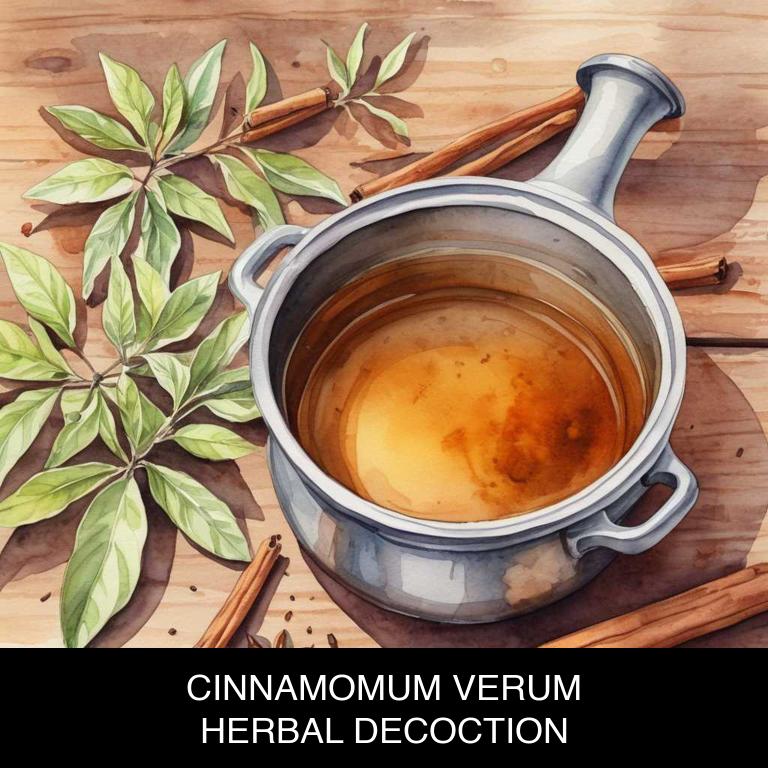
Medicinal Constituents
The list below shows the primary medicinal constituents in Cinnamomum verum decoctions that help with gum pain.
- Cinnamaldehyde: This terpene helps with gum pain by exhibiting anti-inflammatory properties, reducing swelling and discomfort in the gums.
- Eugenol: This phenolic compound helps with gum pain by acting as a local anesthetic, numbing the pain and reducing sensitivity in the gums.
- Cinnamomin: This lignan helps with gum pain by exhibiting antimicrobial properties, preventing the growth of bacteria that can cause gum infections and pain.
Parts Used
The list below shows the primary parts of ceylon cinnamon used to make decoctions for gum pain.
- Leaves: They are rich in antioxidants and have analgesic properties that reduce gum inflammation and pain.
- Rhyzomes: They contain cinnamaldehyde and other compounds that have anti-inflammatory and analgesic effects, providing relief from gum pain.
Quick Recipe
The following recipe gives a procedure to make a basic ceylon cinnamon for gum pain.
- Harvest 30-60 grams of fresh cinnamomum verum bark in the morning after the dew has evaporated.
- Chop the harvested cinnamomum verum bark into small pieces to release its active compounds.
- Steep 10-20 grams of the chopped cinnamomum verum bark in 1 liter of boiling water for 5-10 minutes.
- Strain the decoction through a cheesecloth or a fine-mesh sieve to remove the solids.
- Store the prepared cinnamomum verum decoction in the refrigerator for up to 24 hours.
7. Echinacea angustifolia
Kansas coneflower decoctions helps with gum pain because of its anti-inflammatory properties, which effectively reduce swelling and discomfort in the gums.
The decoction's flavonoids and terpenes also have antimicrobial activities, combating bacterial infections that can cause inflammation and pain. Additionally, Kansas coneflower contains salicylic acid, a compound similar to aspirin, which helps alleviate gum pain and soreness.
As a natural remedy, it provides relief from gum pain without harsh chemicals or medications.

Medicinal Constituents
The list below shows the primary medicinal constituents in Echinacea angustifolia decoctions that help with gum pain.
- Iridoid glycosides: Iridoid glycosides in Echinacea angustifolia have anti-inflammatory properties that can help reduce swelling and pain associated with gum inflammation.
- Alkylamides: Alkylamides in Echinacea angustifolia have been shown to have analgesic and anti-inflammatory effects, which can help alleviate gum pain and discomfort.
- Caffeic acid derivatives: Caffeic acid derivatives in Echinacea angustifolia have antioxidant and anti-inflammatory properties that can help protect the gums from damage and reduce pain associated with gum inflammation.
Parts Used
The list below shows the primary parts of kansas coneflower used to make decoctions for gum pain.
- Roots: They contain alkylamides and glycosides which have anti-inflammatory properties, helping to alleviate gum pain.
- Roots: They also contain echinacoside, a compound that has been shown to have analgesic and anti-inflammatory effects, making them effective in treating gum pain.
- Roots: The roots of Echinacea angustifolia have been traditionally used to reduce inflammation and kill bacteria in the gums, making them a popular choice for gum pain decoctions.
Quick Recipe
The following recipe gives a procedure to make a basic kansas coneflower for gum pain.
- Gather 1-2 teaspoons of dried echinacea angustifolia root and 4 cups of water for decoction.
- Combine the dried root with water in a saucepan and bring to a boil.
- Reduce heat and simmer for 10-15 minutes or until the liquid has reduced slightly.
- Strain the decoction through a cheesecloth or fine-mesh sieve into a bowl or container.
- Store the cooled decoction in an airtight container in the refrigerator for up to 3 days.
8. Hypericum perforatum
St John's Wort decoctions helps with gum pain because of its natural anti-inflammatory properties, which reduce swelling and discomfort in the gums.
The herb's active compounds, such as hyperforin and hypericin, have been shown to inhibit the production of prostaglandins, which are known to cause inflammation and pain.
By reducing inflammation, St John's Wort decoctions provide relief from gum pain, allowing individuals to manage conditions like gingivitis and periodontal disease more effectively.

Medicinal Constituents
The list below shows the primary medicinal constituents in Hypericum perforatum decoctions that help with gum pain.
- Hyperforin: Hyperforin is a phenolic compound that has anti-inflammatory properties, which can help alleviate gum pain by reducing inflammation and swelling in the affected area.
- Hypericin: Hypericin is a naphthodianthone derivative that has antimicrobial properties, which can help fight off bacterial infections that cause gum pain, such as periodontitis.
- Quercetin: Quercetin is a flavonoid that has anti-inflammatory and antioxidant properties, which can help reduce gum inflammation, prevent tissue damage, and promote healing in the affected area.
Parts Used
The list below shows the primary parts of st john's wort used to make decoctions for gum pain.
- Leaves: Used in decoctions due to their bioactive compounds, including hyperforin and hypericin, which have anti-inflammatory and antimicrobial properties that help reduce gum pain and inflammation.
- Flowers: Utilized in decoctions because of their flavonoids and phenolic acids, which possess anti-inflammatory and antioxidant properties that aid in relieving gum pain and promoting healing.
- Roots: Employed in decoctions due to their alkaloids, flavonoids, and phenolic acids, which have anti-inflammatory and antimicrobial effects that help alleviate gum pain and prevent infections.
Quick Recipe
The following recipe gives a procedure to make a basic st john's wort for gum pain.
- Harvest 25-50 grams of fresh hypericum perforatum flowers and leaves from a clean environment to use for decoction.
- Crush the harvested hypericum perforatum flowers and leaves into a fine powder using a mortar and pestle.
- Combine the crushed hypericum powder with 500 milliliters of water in a saucepan and bring to a boil.
- Reduce the heat to a simmer and let the decoction steep for 15-30 minutes to release active compounds.
- Strain the decoction through a cheesecloth or a fine-mesh sieve into a clean container and discard the solids.
9. Viburnum opulus
Guelder rose decoctions helps with gum pain because it contains astringent compounds that help reduce inflammation and bleeding in the gums.
The decoction's antiseptic properties also prevent bacterial growth, promoting a healthy oral environment. Additionally, guelder rose has anti-inflammatory and analgesic properties that help alleviate pain and discomfort caused by gum disease or injury.
By reducing swelling and inflammation, guelder rose decoctions provide relief from gum pain and promote overall oral health.
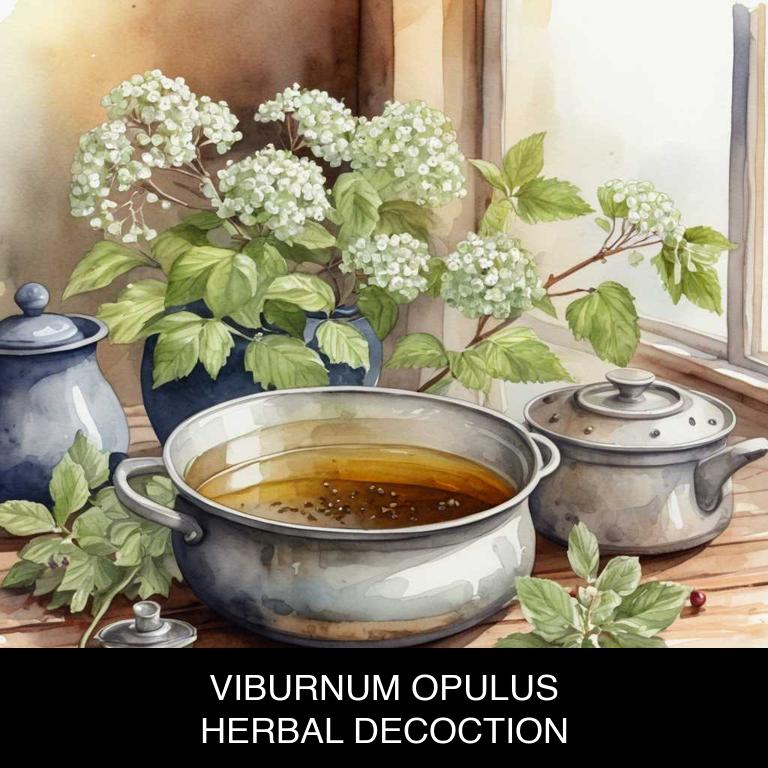
Medicinal Constituents
The list below shows the primary medicinal constituents in Viburnum opulus decoctions that help with gum pain.
- Tannins: Tannins help with gum pain by providing astringent properties that reduce inflammation and prevent excessive bleeding from gums.
- Viburnin: Viburnin has anti-inflammatory properties that help alleviate pain and swelling associated with gum infections and inflammation.
- Flavonoids: Flavonoids, particularly Rutin, have antioxidant and anti-inflammatory properties that help reduce gum inflammation, pain, and bleeding by promoting collagen synthesis and improving blood vessel health.
Parts Used
The list below shows the primary parts of guelder rose used to make decoctions for gum pain.
- Roots: They are used due to their analgesic and anti-inflammatory properties, which help to alleviate gum pain and inflammation.
- Leaves: They are used due to their ability to reduce inflammation and pain, making them effective in soothing gum pain.
- Barks: They are used due to their anti-inflammatory and antibacterial properties, which help to prevent infection and reduce gum pain.
Quick Recipe
The following recipe gives a procedure to make a basic guelder rose for gum pain.
- Gather 20-30 grams of dried viburnum opulus flowers and leaves from a trusted herbal source.
- Crush the dried herbal material into smaller pieces using a mortar and pestle for 10 minutes.
- Combine the crushed herbal material with 500 milliliters of cold water in a saucepan and bring to a boil.
- Reduce heat and simmer the mixture for 10-15 minutes to release the herbal properties.
- Strain the decoction through a cheesecloth or a fine-mesh sieve into a clean container and discard the solids.
10. Artemisia absinthium
Wormwood decoctions helps with gum pain because of its natural anti-inflammatory properties.
The bioactive compounds present in wormwood, such as thujone and sesquiterpene lactones, have been shown to effectively reduce swelling and alleviate discomfort in the gums and surrounding tissues. Additionally, the decoction's antimicrobial properties help combat bacterial infections that can cause gum pain and inflammation, promoting a healthy oral environment.
By targeting both the underlying causes of gum pain, wormwood decoctions offer a natural and holistic approach to relieving discomfort and promoting overall oral health.
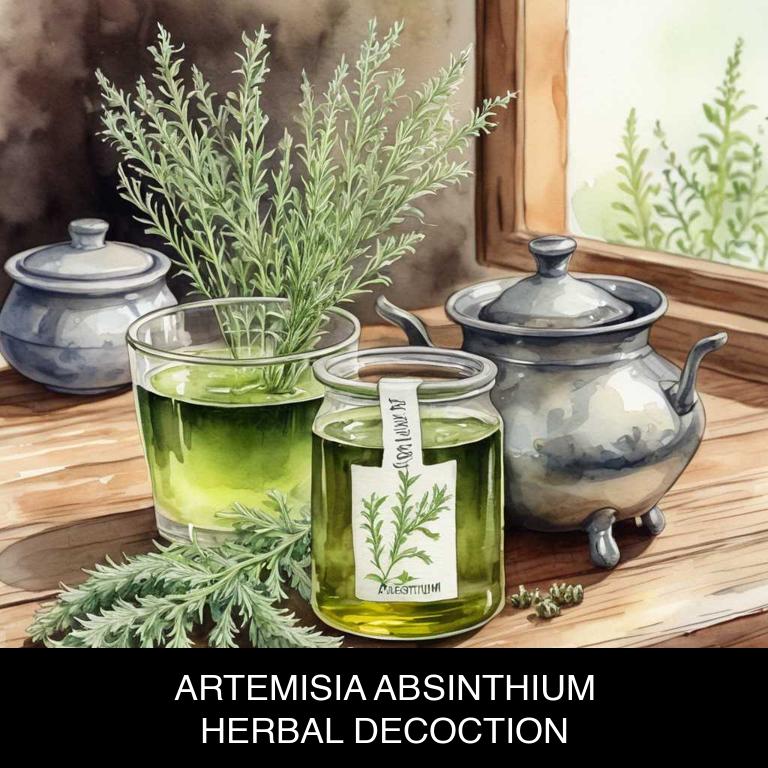
Medicinal Constituents
The list below shows the primary medicinal constituents in Artemisia absinthium decoctions that help with gum pain.
- Thujone: Acts as an anti-inflammatory and pain-relieving agent, helping to reduce swelling and discomfort in the gums.
- Phenolic acids: Exhibits antimicrobial properties, reducing the risk of gum infections and inflammation that can exacerbate pain.
- Cineole: Demonstrates analgesic and anti-inflammatory properties, helping to alleviate gum pain and reduce inflammation in the affected area.
Parts Used
The list below shows the primary parts of wormwood used to make decoctions for gum pain.
- Leaves: The leaves of Artemisia absinthium are the most commonly used part for decoctions due to their high concentration of essential oils and active compounds that provide pain relief.
- Stems: The stems of Artemisia absinthium contain a higher concentration of flavonoids and other compounds that have anti-inflammatory properties, making them useful for gum pain.
- Leaves: The leaves are also used for their analgesic and anti-inflammatory properties, which help to reduce pain and inflammation in the gums.
Quick Recipe
The following recipe gives a procedure to make a basic wormwood for gum pain.
- Harvest approximately 1 ounce of fresh or 2 ounces of dried artemisia absinthium leaves and flowers from a trusted source.
- Chop the harvested material into small pieces to release the oils and flavor compounds for extraction.
- Combine the chopped material with 2 cups of boiling water in a heat-resistant container to create the decoction.
- Simmer the mixture at a low heat for 10 to 15 minutes to extract the beneficial compounds from the herbs.
- Strain the decoction through a cheesecloth or fine-mesh sieve into a clean container to remove the solids.
What is the best combination of herbal decoctions to use for gum pain?
The best combination of herbal decoctions that help with gum pain is a blend of sage, peppermint, and eucalyptus.
Sage helps to reduce inflammation and promote healing, while peppermint eases pain and discomfort. Eucalyptus, with its antimicrobial properties, helps to prevent infection and promote a healthy gum environment.
To use, combine equal parts of dried sage and peppermint leaves with a few sprigs of eucalyptus in a cup of boiling water, let it steep for 5-7 minutes, and then strain and drink.
What ailments similar to gum pain are treated with herbal decoctions?
Ailments similar to gum pain that are treated with herbal decoctions are mouth sores, toothaches, and bad breath.
Herbal decoctions can provide relief from these conditions by soothing inflammation, reducing pain, and freshening the breath.
Decoctions made from herbs like chamomile, peppermint, and ginger have antibacterial properties that help combat infections and promote healing in the mouth and gums.